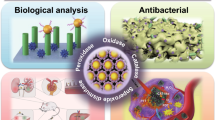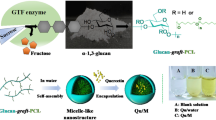Abstract
A versatile method for the design of polydopamine-coated magnetic material with a brush-like structure used for Candida Rugosa lipase (CRL) immobilization was reported in this work. First, polydopamine (PDA) was coated on the surface of Fe3O4 nanospheres (Fe3O4 NPs) with a controllable thickness via dip coating process, and CRL can be immobilized on it directly via covalent bonding. Subsequently, PDA-functionalized Fe3O4 NPs were modified with dialdehyde polyethylene glycol (PEG) to obtain the aldehyde groups, and the brush-like structure of the magnetic supports was formed. After being characterized with various methods, it was verified that the prepared magnetic NPs possessed good monodispersity and displayed high saturation magnetization after modification. Meanwhile, the CRL was immobilized on it covalently, and the enzyme activities such as activity, stability, and reusability were investigated. Significantly, the versatility of polydopamine-inspired chemistry combined with the unique biological nature and tunability with dialdehyde PEG could evoke the efficiency of the CRL, making this a promising coating technique for various bio-applications.









Similar content being viewed by others
References
Bai S, Guo Z, Liu W, Sun Y (2006) Resolution of (±)-menthol by immobilized Candida rugosa lipase on superparamagnetic nanospheres. Food Chem 96:1–7. doi:10.1016/j.foodchem.2005.01.047
Bradford MM (1976) A rapid and sensitive method for the quantitation of microgram quantities of protein utilizing the principle of protein-dye binding. Anal Biochem 72:248–254. doi:10.1016/0003-2697(76)90527-3
Cui YJ (2012) Preparation of novel magnetic polymer carrier, lipase immobilization and their application on chiral separation of ketoprofen. Dissertation, University of Lanzhou
Cui JW, Ju Y, Liang K, Ejima H, Lörcher S, Gause KT, Richardson JJ, Caruso F (2014) Nanoscale engineering of low-fouling surfaces through polydopamine immobilisation of zwitterionic peptides. Soft Matter 10:2656–2663. doi:10.1039/c3sm53056f
Dreyer DR, Miller DJ, Freeman BD, Paul DR, Bielawski CW (2012) Elucidating the structure of poly(dopamine). Langmuir 28:6428–6435. doi:10.1021/la204831b
Faure E, Daudré CF, Jérôme C, Lyskawa J, Fournier D, Woisel P, Detrembleur C (2013) Catechols as versatile platforms in polymer chemistry. Prog Polym Sci 38:236–270. doi:10.1016/j.progpolymsci.2012.06.004
Hong S, Na YS, Choi S, Song IT, Kim WY, Lee H (2012) Non-covalent self-assembly and covalent polymerization co-contribute to polydopamine formation. Adv Funct Mater 22:4711–4717. doi:10.1002/adfm.201201156
Hurley MJ, Jenner P (2006) What has been learnt from study of dopamine receptors in Parkinson's disease? Pharmacol Ther 111:715–728. doi:10.1016/j.pharmthera.2005.12.001
Jia H, Zhu G, Wang P (2003) Catalytic behaviors of enzymes attached to nanospheres: the effect of particle mobility. Biotechnol Bioeng 84:406–414. doi:10.1002/bit.10781
Katz JL, Newman AH, Izenwasser S (1997) Relations between heterogeneity of dopamine transporter binding and function and the behavioral pharmacology of cocaine. Pharmacol Biochem Behav 57:505–512. doi:10.1016/S0091-3057(96)00441-8
Kim JB, Grate JW, Wang P (2006) Nanostructures for enzyme stabilization. Chem Eng Sci 61:1017–1026. doi:10.1016/j.ces.2005.05.067
Lee H, Dellatore SM, Miller WM, Messersmith PB (2007) Mussel-inspired surface chemistry for multifunctional coatings. Science 318:426–430. doi:10.1126/science.1147241
Liebscher J, Mrówczyński R, Scheidt HA, Filip C, Hǎdade ND, Turcu R, Bende A, Beck S (2013) Structure of polydopamine: a never-ending story? Langmuir 29:10539–10548. doi:10.1021/la4020288
Liu X, Chen X, Li YF, Wang XY, Peng XM, Zhu WW (2012) Preparation of superparamagnetic Fe3O4@Alginate/chitosan nanospheres for Candida rugosa lipase immobilization and utilization of layer-by-layer assembly to enhance the stability of immobilized lipase. ACS Appl Mater Interfaces 4:5169–5178. doi:10.1021/am301104c
Liu T, Zhao YD, Wang XF, Li X, Yan YJ (2013) A novel oriented immobilized lipase on magnetic nanospheres in reverse micelles system and its application in the enrichment of polyunsaturated fatty acids. Bioresour Technol 132:99–102. doi:10.1016/j.biortech.2012.12.191
Liu YL, Ai KL, Lu LH (2014) Polydopamine and its derivative materials: synthesis and promising applications in energy, environmental, and biomedical fields. Chem Rev 114:5057–5115. doi:10.1021/cr400407a
Martín M, Salazar P, Villalonga R, Campuzano S, Pingarrónd JM, González-Moraa JL (2014) Preparation of core-shell Fe3O4@poly(dopamine) magnetic nanospheres for biosensor construction. J Mater Chem B 2:739–746. doi:10.1039/C3TB21171A
Mateo C, Palomo JM, Fernandez LG, Guisan JM, Fernandez LR (2007) Improvement of enzyme activity, stability and selectivity via immobilization techniques. Enzym Microb Technol 40:1451–1463. doi:10.1016/j.enzmictec.2007.01.018
Nagai N, Kumasaka N, Kawashima T, Ka JH, Nishizawa M, Abe T (2010) Preparation and characterization of collagen microspheres for sustained release of VEGF. J Mater Sci Mater Med 21:1891–1898. doi:10.1007/s10856-010-4054-0
Netto CGCM, Toma HE, Andrade LH (2013) Superparamagnetic nanospheres as versatile carriers and supporting materials for enzymes. J Mol Catal B Enzym 85–86:71–92. doi:10.1016/j.molcatb.2012.08.010
Ni KF, Lu HM, Wang CX, Black KCL, Wei DZ, Ren YH, Messersmith PB (2012) A novel technique for in situ aggregation of gluconobacter oxydans using bio-adhesive magnetic nanospheres. Biotechnol Bioeng 109:2970–2977. doi:10.1002/bit.24582
Omprakash Y, Toyoko I (2005) Covalent-bonded immobilization of lipase on poly (phenylene sulfide) dendrimers and their hydrolysis ability. Biomacromolecules 6:2809–2814. doi:10.1021/bm050285d
Remingtoned G, Giovanni GD, Matteo VD, Esposito E (2008) In serotonin-dopamine interaction: experimental evidence and therapeutic relevance. Prog Brain Res 172:117–140. doi:10.1016/S0079-6123(08)00935-7
Sureshkumar M, Lee CK (2011) Polydopamine coated magnetic-chitin (MCT) particles as a new matrix for enzyme immobilization. Carbohydr Polym 84:775–780. doi:10.1016/j.carbpol.2010.03.036
Wang L, Wei L, Chen Y, Jiang R (2010) Specific and reversible immobilization of NADH oxidase on functionalized carbon nanotubes. J Biotechnol 150:57–63. doi:10.1016/j.jbiotec.2010.07.005
Zeng RJ, Luo ZF, Zhou D, Cao FH, Wang YM (2010) A novel PEG coating immobilized onto capillary through polydopamine coating for separation of proteins in CE. Electrophoresis 31:3334–3341. doi:10.1002/elps.201000228
Zhai YM, Han L, Wang P, Li GP, Ren W, Liu L, Wang EK, Dong SJ (2011) Superparamagnetic plasmonic nanohybrids: shape-controlled synthesis, TEM-induced structure evolution, and efficient sunlight-driven inactivation of bacteria. ACS Nano 5:8562–8570. doi:10.1021/nn201875k
Zheng JN, Xie HG, Yu WT, Liu XD, Xie WY, Zhu J, Ma XJ (2010) Chitosan-g-MPEG-modified alginate/chitosan hydrogel microcapsules: a quantitative study of the effect of polymer architecture on the resistance to protein adsorption. Langmuir 26:17156–17164. doi:10.1021/la1030203
Acknowledgements
The authors thank the financial supports from the National Natural Science Foundation of China (No. 21374045, No. 21074049), the scientific research ability training of under-graduate students majoring in chemistry by the two patters based on the tutorial system and top students (J1103307), and the Opening Foundation of State Key Laboratory of Applied Organic Chemistry (SKLAOC-2009-35).
Author information
Authors and Affiliations
Corresponding author
Rights and permissions
About this article
Cite this article
Hou, C., Zhu, H., Li, Y. et al. Facile synthesis of oxidic PEG-modified magnetic polydopamine nanospheres for Candida rugosa lipase immobilization. Appl Microbiol Biotechnol 99, 1249–1259 (2015). https://doi.org/10.1007/s00253-014-5990-2
Received:
Revised:
Accepted:
Published:
Issue Date:
DOI: https://doi.org/10.1007/s00253-014-5990-2




